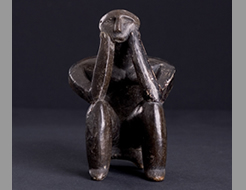|
||||||||||||||||||||||||||||||||
|
|
Museum of: Bucharest | |||||||||||||||||||||||||||||||
| Name of the artefact: The Thinker | ||||||||||||||||||||||||||||||||
|
Burnt clay figurine, modelled in a meditative position,
a rare presence in the prehistoric art, dubbed after a Rodin’s famous
sculpture |
||||||||||||||||||||||||||||||||
|
WHERE IS IT AND MAIN CHARACTERISTICS |
STATE |
|||||||||||||||||||||||||||||||
|
Department: |
Archaeology |
Preservation: |
Good | |||||||||||||||||||||||||||||
|
Inventory number: |
15906 |
Restauration: |
Restored | |||||||||||||||||||||||||||||
|
Name of the artefact: |
The Thinker |
Completeness: |
Almost Complete | |||||||||||||||||||||||||||||
|
Object type: |
Human figurine |
|||||||||||||||||||||||||||||||
|
Material: |
Clay |
|||||||||||||||||||||||||||||||
|
Methof of manufacture: |
Shaping, firing |
|||||||||||||||||||||||||||||||
|
Decoration type: |
No decoration |
|||||||||||||||||||||||||||||||
|
Distinctive mark: |
- |
|||||||||||||||||||||||||||||||
|
DIMENSIONS |
PERIOD OF USE |
|||||||||||||||||||||||||||||||
|
Length (mm): |
- |
Epoque: |
Neolithic |
|||||||||||||||||||||||||||||
|
Heigth
(mm): |
115 |
Culture: |
Hamangia |
|||||||||||||||||||||||||||||
|
Diameter
(mm): |
- |
Period: |
Late Neolithic |
|||||||||||||||||||||||||||||
|
Width (mm): |
75 |
Face: |
- |
|||||||||||||||||||||||||||||
|
Thickness (mm): |
- |
Absolute chronology: |
5000 BC |
|||||||||||||||||||||||||||||
|
Weight
(g): |
- |
|||||||||||||||||||||||||||||||
DISCOVERY |
||||||||||||||||||||||||||||||||
|
Date: |
1956 |
Country: |
Romania |
|||||||||||||||||||||||||||||
|
District: |
Constanţa |
Town hall affiliation: |
Columbia |
|||||||||||||||||||||||||||||
|
Village: |
Cernavodă |
Discovery findspot: |
Columbia |
|||||||||||||||||||||||||||||
|
Condition of discovery: |
Chance Discovery |
Discovery type: |
Grave |
|||||||||||||||||||||||||||||
|
ANALYSES – DETERMINATIONS |
FILLED IN BY |
|||||||||||||||||||||||||||||||
|
Type: |
- |
Name: |
Radian Andreescu, Katia Moldoveanu |
|||||||||||||||||||||||||||||
|
Laboratory: |
- |
Institution: |
Romanian National History Museum |
|||||||||||||||||||||||||||||
|
No./Code: |
- |
Date: |
23/02/2005 |
|||||||||||||||||||||||||||||
|
DEEPENINGS |
||||||||||||||||||||||||||||||||
|
Morphology of the object: |
||||||||||||||||||||||||||||||||
|
The statuette was discovered at Cernavoda, in a
funerary context, together with a feminine statuette. The Thinker is
made of polished, dark-grey clay representing a sitting man on a small
chair. The head quite oval has the face with modelled nose, the eyes
depict by triangular impressions and the mouth marked by a small hole. A
very long neck supports the head. The body is slightly curved and the
legs are bending. The bend arms are placed on the knees and the hands
hold the head. This position obviously suggests a thinking attitude from
where the nick name of the statuette -The Thinker. |
||||||||||||||||||||||||||||||||
|
Decoration: |
||||||||||||||||||||||||||||||||
|
- |
||||||||||||||||||||||||||||||||
|
Inscription: |
||||||||||||||||||||||||||||||||
|
- |
||||||||||||||||||||||||||||||||
|
Analogies: |
||||||||||||||||||||||||||||||||
|
The figurine was discovered in the necropolis of
Cernavodă which contains more than 400 inhumation graves. The grave
goods include stone axes, pots, bracelets, anthropomorphic figurines.
Even though the figurines discovered so far are similar in what concern
their morphology, the position in which the Thinker is modelled makes it
special. A little clay figurine, roughly modelled in a similar position
was found at Truşeşti, in the aria of Cucuteni culture. |
||||||||||||||||||||||||||||||||
|
Interpretation: |
||||||||||||||||||||||||||||||||
|
The attitude of thinking of this statuette could be
linked to meditation about life and death, considering that the artefact
belongs to a funerary context. The Thinker was also interpreted as a
vegetation God that has to die in order to resurrect the following
spring, or as a Death God, consort of the great Goddess. |
||||||||||||||||||||||||||||||||
|
Bibliography: |
||||||||||||||||||||||||||||||||
|
Berciu, D. 1961, Contribuţii la problemele neoliticului
în România în lumina noilor cercetări, Bucureşti, Romania; Berciu, D.
1962, Deux chefs d'oeuvre de l'art néolithique en Roumanie: le "couple"
de la civilisation de Hamangia, Dacia, N.S. VI; Dumitrescu, Vl. 1974,
Arta preistorică în România, Bucureşti, România; Gimbutas,M. 1974, The
Gods and Goddesses of Old Europe, London, UK; Gimbutas,M. 1989, The
language of the Goddess, San Francisco, USA |
||||||||||||||||||||||||||||||||

